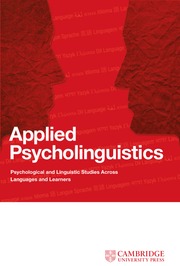Crossref Citations
This article has been cited by the following publications. This list is generated based on data provided by
Crossref.
Nittrouer, Susan
2002.
From Ear to Cortex.
Language, Speech, and Hearing Services in Schools,
Vol. 33,
Issue. 4,
p.
237.
Nittrouer, Susan
2002.
Learning to perceive speech: How fricative perception changes, and how it stays the same.
The Journal of the Acoustical Society of America,
Vol. 112,
Issue. 2,
p.
711.
THOMPKINS, AMANDA C.
and
BINDER, KATHERINE S.
2003.
A comparison of the factors affecting reading performance of functionally illiterate adults and children matched by reading level.
Reading Research Quarterly,
Vol. 38,
Issue. 2,
p.
236.
Hester, Elizabeth
and
Hodson, Barbara Williams
2004.
The role of phonological representation in decoding skills of young readers.
Child Language Teaching and Therapy,
Vol. 20,
Issue. 2,
p.
115.
Nittrouer, Susan
2005.
Age-related differences in weighting and masking of two cues to word-final stop voicing in noise.
The Journal of the Acoustical Society of America,
Vol. 118,
Issue. 2,
p.
1072.
Nittrouer, Susan
and
Burton, Lisa Thuente
2005.
The role of early language experience in the development of speech perception and phonological processing abilities: evidence from 5-year-olds with histories of otitis media with effusion and low socioeconomic status.
Journal of Communication Disorders,
Vol. 38,
Issue. 1,
p.
29.
Dally, Kerry
2006.
The influence of phonological processing and inattentive behavior on reading acquisition..
Journal of Educational Psychology,
Vol. 98,
Issue. 2,
p.
420.
Steinbrink, Claudia
and
Klatte, Maria
2008.
Phonological working memory in German children with poor reading and spelling abilities.
Dyslexia,
Vol. 14,
Issue. 4,
p.
271.
Lewis, Dawna
Hoover, Brenda
Choi, Sangsook
and
Stelmachowicz, Patricia
2010.
Relationship Between Speech Perception in Noise and Phonological Awareness Skills for Children With Normal Hearing.
Ear & Hearing,
Vol. 31,
Issue. 6,
p.
761.
Johnson, Erin Phinney
Pennington, Bruce F.
Lowenstein, Joanna H.
and
Nittrouer, Susan
2011.
Sensitivity to structure in the speech signal by children with speech sound disorder and reading disability.
Journal of Communication Disorders,
Vol. 44,
Issue. 3,
p.
294.
Nittrouer, Susan
2012.
A New Perspective on Developmental Language Problems: Perceptual Organization Deficits.
Perspectives on Language Learning and Education,
Vol. 19,
Issue. 3,
p.
87.
Nittrouer, Susan
Caldwell-Tarr, Amanda
Tarr, Eric
Lowenstein, Joanna H.
Rice, Caitlin
and
Moberly, Aaron C.
2013.
Improving speech-in-noise recognition for children with hearing loss: Potential effects of language abilities, binaural summation, and head shadow.
International Journal of Audiology,
Vol. 52,
Issue. 8,
p.
513.
Nittrouer, Susan
and
Lowenstein, Joanna H.
2013.
Perceptual organization of speech signals by children with and without dyslexia.
Research in Developmental Disabilities,
Vol. 34,
Issue. 8,
p.
2304.
Caldwell, Amanda
and
Nittrouer, Susan
2013.
Speech Perception in Noise by Children With Cochlear Implants.
Journal of Speech, Language, and Hearing Research,
Vol. 56,
Issue. 1,
p.
13.
Nittrouer, Susan
Caldwell-Tarr, Amanda
and
Lowenstein, Joanna H.
2013.
Working memory in children with cochlear implants: Problems are in storage, not processing.
International Journal of Pediatric Otorhinolaryngology,
Vol. 77,
Issue. 11,
p.
1886.
Nittrouer, Susan
Caldwell-Tarr, Amanda
Sansom, Emily
Twersky, Jill
and
Lowenstein, Joanna H.
2014.
Nonword Repetition in Children With Cochlear Implants: A Potential Clinical Marker of Poor Language Acquisition.
American Journal of Speech-Language Pathology,
Vol. 23,
Issue. 4,
p.
679.
Nittrouer, Susan
Caldwell-Tarr, Amanda
Moberly, Aaron C.
and
Lowenstein, Joanna H.
2014.
Perceptual weighting strategies of children with cochlear implants and normal hearing.
Journal of Communication Disorders,
Vol. 52,
Issue. ,
p.
111.
NITTROUER, SUSAN
and
LOWENSTEIN, JOANNA H.
2014.
Separating the effects of acoustic and phonetic factors in linguistic processing with impoverished signals by adults and children.
Applied Psycholinguistics,
Vol. 35,
Issue. 2,
p.
333.
Hu, Chieh-Fang
2014.
Extracting Phonological Patterns for L2 Word Learning: The Effect of Poor Phonological Awareness.
Journal of Psycholinguistic Research,
Vol. 43,
Issue. 5,
p.
569.
Nittrouer, Susan
and
Caldwell-Tarr, Amanda
2016.
Pediatric Cochlear Implantation.
p.
177.

